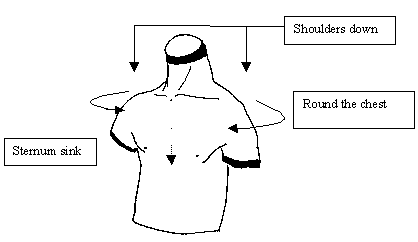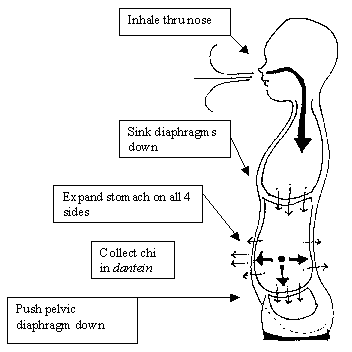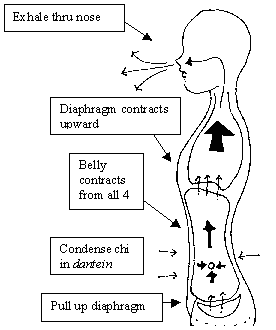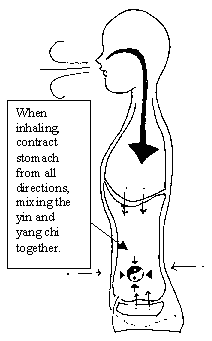 BREATHING
BREATHING
 BREATHING
BREATHING
- General rules about breathing:
All breathing should be done thru the
nose. We have more control over the breath thru our nose than out mouth. The nose acts as
a filter and it moisturizes the air as it comes in. Originate your breathing from your
Real Dantien, located between your lower dantein and ming-men point. Use your belly to
help you breathe, not your chest. This kind of breathing is called "Abdominal
Breathing". When we breathe in air, we are absorbing energy from the air. If we use
our belly to breathe, the diaphragm sinks down, creating more room to hold the air in,
thus we can absorb more energy. It also charges up our blood with plenty of oxygen.
Improve our vitality by supporting our body with oxygen-rich blood. Another good side
effect of Abdominal Breathing is its calming effect. It helps us relax. Often, many
Energy-Work, such as Tai Chi, Yoga, Taoist Inner Alchemy, and other meditation arts, start
out their practice with a series of Abdominal Breathing to calm down the mind of the
practitioners. When practice Abdominal Breathing regularly, the breathing will be slow and
deep; which is the ultimate goal in breathing. When our breathing is deep, we can take in
more air. When our breathing is slow, we have more time to fully digest the energy within
the air. To maximize our breathing capacity, relax your chest by sinking the sternum and
dropping the shoulder. Then round your chest from the scapulas by pushing your arms
slightly forward and to the sides, creating a gap in the armpits. The reason to round the
chest is to take the pressure off the sides of your rib cage, which in turn take the
pressure off your chest. Relax and do not force your breath! see diagram>

Normal Breathing
-There is two basic breathing patterns we use. First one is called "Normal Breathing", since it is the way we breathe normally. The stomach expands as we breathe in, contracts as we breathe out. Sometimes it is referred to as "Buddhist Breathing" or "Post-Birth Breathing". It is the breathing pattern we use after our birth. When we are in a relaxed state, we use Normal Breathing, such as the time before we go to sleep or as you are sitting down and reading this paper. As we breathe in, we are conceiving, so it is yin in nature. As we breathe out, we are expanding, so it is yang in nature. When you have the chance, observe other animals as they breathe or even newborn baby. They breathe with their belly naturally.

-During inhalations of Normal Breathing, expand the belly on all four sides (forward, backward, and sideways). Sink both the thoracic diaphragm and the pelvic diaphragm. Inhale and gather the chi in the dantien.

-When exhaling, the belly contracts from all four sides. Both the chest diaphragm and the pelvic contract, lift upward pushing the air out. Breathe out thru the nose. Exhale and condense the chi in the dantein.
Reverse Breathing
-The other breathing method is called "Reverse Breathing". Also known as the "Taoist Breathing" or "Pre-Birth Breathing". The stomach contracts as we breathe in, and expands as we breathe out. It is the reverse of the Normal Breathing. It is the breathing method we use before birth, when we are still in the fetus. We use this method when we need some extra energy. When you are excited, exhausted, or exercising, you will find yourself breathing in Reverse. Be very cautious when practicing Reverse Breathing. Do not practice more than 3 minutes at a time, and don’t force it or you may injure yourself. Reverse Breathing is more difficult to practice than Normal Breathing. Do what is natural to you, and do it at your own pace.


- When inhaling, the belly contracts from all 4 sides. While the thoracic diaphragm moves downward, the pelvic diaphragm is moving upward, forcing the yin and yang chi to mix together at the Real Dantein.